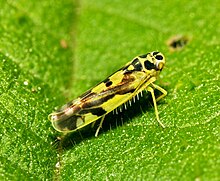Leaf hoppers
| Leaf hoppers | ||||||||||||
|---|---|---|---|---|---|---|---|---|---|---|---|---|

Garden leaf cicada ( Eupteryx florida ) |
||||||||||||
| Systematics | ||||||||||||
|
||||||||||||
| Scientific name | ||||||||||||
| Typhlocybinae | ||||||||||||
| Cherry Tree , 1868 |
The leaf cicadas (Typhlocybinae) are a worldwide widespread, probably monophyletic subfamily of the dwarf cicadas (Cicadellidae) within the hemiptera suborder of the round head cicadas (Cicadomorpha). They are mostly very small and delicate insects with a pronounced jumping ability.
features
Most species of leaf hoppers lack the ocelles despite their ability to fly . They are all small and mostly very slim and delicate shapes with diverse, often lively colors and patterns. The insects are predominantly long-winged (macropter), few species have shortened hind wings. The veins in the basal part of the forewings are, in contrast to the pointed third, mostly indistinct and without transverse veins or branches. Most species are 2 millimeters long; Central European species often reach no more than 5 millimeters in length. In many genera it is only possible to differentiate between species based on the sexual apparatus of the male.
Habitat and way of life



A number of species are colonists of various deciduous trees, sometimes also of conifers , they are arboricolous . Other species live in the herb layer on perennials and herbs , dwarf shrubs as well as sweet grasses and ferns . Leaf cicadas, like all cicadas, feed on plant juices (phytosug), which they ingest with their specially built mouthparts. They suck up the cell associations between the epidermal layers of the leaves ( mesophyll ).
Reproduction and development
Mating is initiated by the male by anchoring the genital fittings to that of the female. The male initially sits diagonally next to the female. This V-position, which is characteristic of other groups of cicadas, is not retained in the leaf cicadas. After the coupling this becomes antagonistic. The angle increases to 180 ° so that the male and the female sit on the substrate with their heads turned away from each other .
Leaf hoppers are hemimetabolic . The larvae develop directly. The larvae and the adult animals basically have the same body structure. With increasing age, the systems for the wings and genital fittings grow and grow. Leaf cicadas go through five larval stages. They form two generations in Central Europe, and possibly three more generations a year in Southern Europe. They overwinter in the ice stage.
Taxonomy
Worldwide there are around 3240 species in 79 leaf cicadas genera. In Europe there are 382 species in 48 genera, which are divided into six tribes. The most species-rich genera from Europe include Edwardsiana, Eupteryx, Kybos and Zygina . In Central Europe there are 219 species in 36 genera, of which 158 species occur in 34 genera in Germany.
European tribe and species selection
- Alebrini
- Dikraneurini
- Empoascini
- Erythroneurini
- Fire cicada ( Zygina flammigera ( Fourcroy , 1785))
- Typhlocybini
- Gold leaf cicada ( Eupteryx aurata ( Linnaeus , 1758))
- Beech leaf cicada ( Fagocyba cruenta var. Douglasii ( Herrich-Schäffer , 1838))
- Ligurian leaf cicada ( Eupteryx decemnotata Rey , 1891)
- Garden leaf cicada ( Eupteryx florida Ribaut , 1936)
- Herb leaf cicada ( Eupteryx melissae Curtis , 1837)
- Eupteryx atropunctata
- Maple elf cicada ( Eurhadina loewii ( Then , 1886))
- Beautiful elf cicada ( Eurhadina pulchella ( Fallén , 1806))
- Ribautiana tenerrima ( Herrich-Schäffer , 1834)
- Rose leafhopper ( Typhlocyba rosae ( Linnaeus , 1758))
- Zyginellini
Economical meaning
Many species of leaf hoppers are potential pests, especially on aromatic and medicinal herbs. In the case of a very high individual density of the leafhoppers, the suckling activity can lead to a loss of vitality and ultimately to the death of the host plants.
literature
The information comes from the following literature:
- R. Biedermann & R. Niedringhaus: The cicadas of Germany - identification tables for all species. Fründ, Scheeßel 2004, ISBN 3-00-012806-9 .
- R. Remane & E. Wachmann : Cicadas - get to know, observe. Naturbuch Verlag, Augsburg 1993, ISBN 3-89440-044-7 .
- H. Nickel: The leafhoppers and planthoppers of Germany (Hemiptera, Auchenorrhyncha): Patterns and strategies in a highly diverse group of phytophagous insects. Pensoft, Sofia and Moscow 2003, ISBN 954-642-169-3 .
Single sources
The following sources are cited for individual aspects:
- ↑ Typhlocybinae in Fauna Europaea , as of March 2, 2015.
- ↑ WE Holzinger et al. (1997): Preliminary list of cicadas from Central Europe (Insecta: Auchenorrhyncha) . Contributions to cicada lore 1: 43-62. ( PDF; 122 kB ), accessed on August 17, 2016
- ↑ Herbert Nickel and Reinhard Remane: List of species of cicadas in Germany, with information on nutrient plants, food breadth, life cycle, area and endangerment (Hemiptera, Fulgoromorpha et Cicadomorpha). Contributions to the cicada, 5, pp. 27–64, 2002 full text (PDF, German; 234 kB)
- Jump up ↑ H. Nickel & WE Holzinger: Rapid range expansion of Ligurian leafhopper, Eupteryx decemnotata Rey, 1891 (Hemiptera, Cicadellidae), a potential pest of garden and greenhouse herbs, in Europe. - Russian Journal of Entomology 2006, 15 (3): 57-63 ( PDF ).